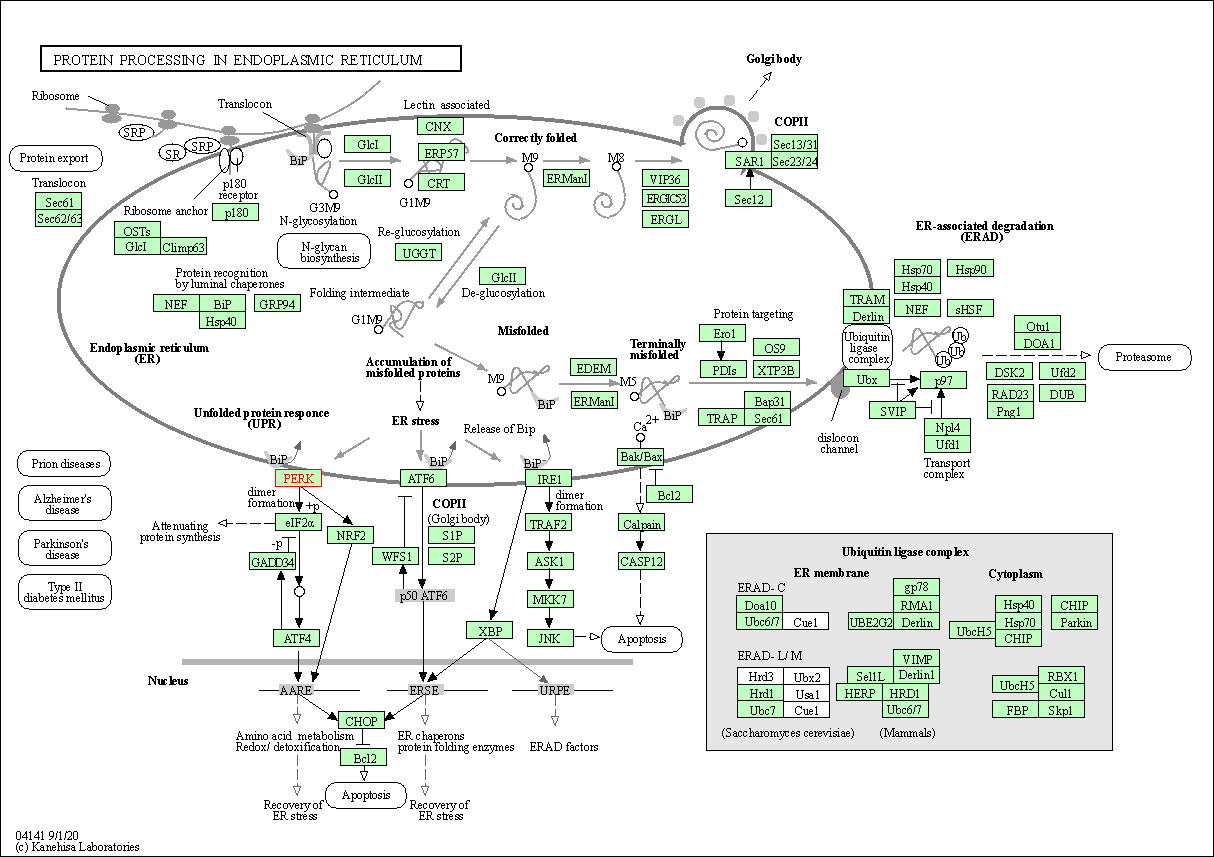Target Information
| Target General Information | Top | |||||
|---|---|---|---|---|---|---|
| Target ID |
T02439
(Former ID: TTDI03188)
|
|||||
| Target Name |
Eukaryotic translation initiation factor 2-alpha kinase 1 (EIF2AK1)
|
|||||
| Synonyms |
PRO1362; KIAA1369; Hemin-sensitive initiation factor 2-alpha kinase; Heme-regulated inhibitor; Heme-regulated eukaryotic initiation factor eIF-2-alpha kinase; HRI
Click to Show/Hide
|
|||||
| Gene Name |
EIF2AK1
|
|||||
| Target Type |
Literature-reported target
|
[1] | ||||
| Function |
Inhibits protein synthesis at the translation initiation level, in response to various stress conditions, including oxidative stress, heme deficiency, osmotic shock and heat shock. Exerts its function through the phosphorylation of EIF2S1 at 'Ser-48' and 'Ser-51', thus preventing its recycling. Binds hemin forming a 1:1 complex through a cysteine thiolate and histidine nitrogenous coordination. This binding occurs with moderate affinity, allowing it to sense the heme concentration within the cell. Thanks to this unique heme-sensing capacity, plays a crucial role to shut off protein synthesis during acute heme-deficient conditions. In red blood cells (RBCs), controls hemoglobin synthesis ensuring a coordinated regulation of the synthesis of its heme and globin moieties. Thus plays an essential protective role for RBC survival in anemias of iron deficiency. Similarly, in hepatocytes, involved in heme-mediated translational control of CYP2B and CYP3A and possibly other hepatic P450 cytochromes. May also contain ER stress during acute heme-deficient conditions (By similarity).
Click to Show/Hide
|
|||||
| UniProt ID | ||||||
| EC Number |
EC 2.7.11.1
|
|||||
| Sequence |
MQGGNSGVRKREEEGDGAGAVAAPPAIDFPAEGPDPEYDESDVPAEIQVLKEPLQQPTFP
FAVANQLLLVSLLEHLSHVHEPNPLRSRQVFKLLCQTFIKMGLLSSFTCSDEFSSLRLHH NRAITHLMRSAKERVRQDPCEDISRIQKIRSREVALEAQTSRYLNEFEELAILGKGGYGR VYKVRNKLDGQYYAIKKILIKGATKTVCMKVLREVKVLAGLQHPNIVGYHTAWIEHVHVI QPRADRAAIELPSLEVLSDQEEDREQCGVKNDESSSSSIIFAEPTPEKEKRFGESDTENQ NNKSVKYTTNLVIRESGELESTLELQENGLAGLSASSIVEQQLPLRRNSHLEESFTSTEE SSEENVNFLGQTEAQYHLMLHIQMQLCELSLWDWIVERNKRGREYVDESACPYVMANVAT KIFQELVEGVFYIHNMGIVHRDLKPRNIFLHGPDQQVKIGDFGLACTDILQKNTDWTNRN GKRTPTHTSRVGTCLYASPEQLEGSEYDAKSDMYSLGVVLLELFQPFGTEMERAEVLTGL RTGQLPESLRKRCPVQAKYIQHLTRRNSSQRPSAIQLLQSELFQNSGNVNLTLQMKIIEQ EKEIAELKKQLNLLSQDKGVRDDGKDGGVG Click to Show/Hide
|
|||||
| 3D Structure | Click to Show 3D Structure of This Target | AlphaFold | ||||
| Cell-based Target Expression Variations | Top | |||||
|---|---|---|---|---|---|---|
| Cell-based Target Expression Variations | ||||||
| Different Human System Profiles of Target | Top |
|---|---|
|
Human Similarity Proteins
of target is determined by comparing the sequence similarity of all human proteins with the target based on BLAST. The similarity proteins for a target are defined as the proteins with E-value < 0.005 and outside the protein families of the target.
A target that has fewer human similarity proteins outside its family is commonly regarded to possess a greater capacity to avoid undesired interactions and thus increase the possibility of finding successful drugs
(Brief Bioinform, 21: 649-662, 2020).
Human Pathway Affiliation
of target is determined by the life-essential pathways provided on KEGG database. The target-affiliated pathways were defined based on the following two criteria (a) the pathways of the studied target should be life-essential for both healthy individuals and patients, and (b) the studied target should occupy an upstream position in the pathways and therefore had the ability to regulate biological function.
Targets involved in a fewer pathways have greater likelihood to be successfully developed, while those associated with more human pathways increase the chance of undesirable interferences with other human processes
(Pharmacol Rev, 58: 259-279, 2006).
Biological Network Descriptors
of target is determined based on a human protein-protein interactions (PPI) network consisting of 9,309 proteins and 52,713 PPIs, which were with a high confidence score of ≥ 0.95 collected from STRING database.
The network properties of targets based on protein-protein interactions (PPIs) have been widely adopted for the assessment of target’s druggability. Proteins with high node degree tend to have a high impact on network function through multiple interactions, while proteins with high betweenness centrality are regarded to be central for communication in interaction networks and regulate the flow of signaling information
(Front Pharmacol, 9, 1245, 2018;
Curr Opin Struct Biol. 44:134-142, 2017).
Human Similarity Proteins
Human Pathway Affiliation
Biological Network Descriptors
|
|
| KEGG Pathway | Pathway ID | Affiliated Target | Pathway Map |
|---|---|---|---|
| Protein processing in endoplasmic reticulum | hsa04141 | Affiliated Target |

|
| Class: Genetic Information Processing => Folding, sorting and degradation | Pathway Hierarchy | ||
| Degree | 3 | Degree centrality | 3.22E-04 | Betweenness centrality | 0.00E+00 |
|---|---|---|---|---|---|
| Closeness centrality | 1.87E-01 | Radiality | 1.31E+01 | Clustering coefficient | 1.00E+00 |
| Neighborhood connectivity | 6.70E+01 | Topological coefficient | 8.48E-01 | Eccentricity | 13 |
| Download | Click to Download the Full PPI Network of This Target | ||||
| Chemical Structure based Activity Landscape of Target | Top |
|---|---|
| References | Top | |||||
|---|---|---|---|---|---|---|
| REF 1 | Discovery of the first known small-molecule inhibitors of heme-regulated eukaryotic initiation factor 2alpha (HRI) kinase. Bioorg Med Chem Lett. 2009 Dec 1;19(23):6548-51. | |||||
If You Find Any Error in Data or Bug in Web Service, Please Kindly Report It to Dr. Zhou and Dr. Zhang.

